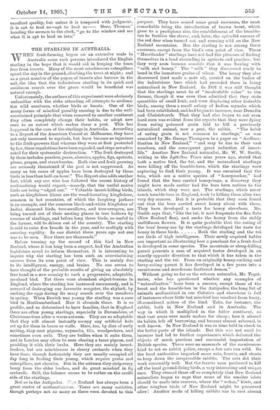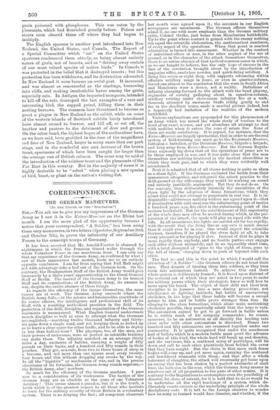W HEN fruit-farming began on an extensive scale in Australia some
rash persons introduced the English starling in the hope that it would aid in keeping the trees free from insects. Many of the most mischievous caterpillars spend the day in the ground, climbing the trees at night ; and as a great number of the pupae of insects also burrow in the soil, the idea that the industrious starling in its quick and assiduous search over the grass would be beneficial was natural enough.
Unfortunately, the authors of this experiment were obviously unfamiliar with the risks attending all attempts to acclima- tise wild creatures, whether birds or beasts. One of the many forms of mischief possibly ensuing is due to the well- ascertained principle that when removed to another continent they often completely change their habits, or adopt new ones to an extent which makes them a pest. This has happened in the case of the starlings in Australia. According to a Report of the American Consul at Melbourne, they have not only increased to myriads, but have become so injurious to the fruit-growers that whereas they were at first protected by law, these regulations have been repealed, and steps are advo- cated for their systematic destruction. "The fruit destroyed by them includes peaches, pears, cherries, apples, figs, apricots, plums, grapes, and strawberries. Both vine and fruit growing are seriously threatened if the pest is not suppressed. As many as ten cases of apples have been destroyed by these birds in less than half-an-hour." The Report also adds another fact, which any one who has followed the recent history of acclimatising would expect, —namely, that the useful native birds are being "edged out." "Valuable insect-killing birds, such as kingfishers (these are the wood-haunting kingfisher; common in hot countries, of which the laughing jackass is an example, and the common black-and-white kingfisher of India), diamond birds, tree-swallows, and tree-creepers, are being turned out of their nesting places in tree hollows by swarms of starlings, and before long these birds, so useful to the farmer, will be driven out of the country. The starling is said to raise five broods in the year, and to multiply with amazing rapidity. In one district three years ago not one was to be seen. Now there are thousands."
Before turning up the record of this bird in New Zealand, where it has long been a suspect, had the Australian legislators cared to inform themselves, it is interesting to inquire why the starling has been such an overwhelming success from its own point of view. This is mainly due to its intelligence, energy, and brains. No one seems to have thought of the probable results of giving an absolutely free hand in a new country to such a progressive, adaptable, go-ahead bird. Yet there were abundant object-lessons in England, where the starling has increased enormously, and is accused of destroying our favourite songster, the skylark, by sucking the eggs during its mazy search over the meadows in spring. When Bewick was young the starling was a rare bird in Northumberland. Now it abounds there. It is so prolific, and so determined to have families, that in England there are often young starlings, especially in Devonshire, at Christmas-time after a warm autumn. They are so adaptable that they will almost instantly occupy any artificial hole set up for them in boxes or walls. Here, too, by dint of early nesting, they oust pigeons, wrynecks, tits, woodpeckers, and sometimes even owls. They are bullies when it suits them, and in London may often be seen chasing a tame pigeon, and prodding it with their beaks. Here they are mainly insect- feeders, but are mischievous in cherry orchards when they have time, though fortunately they are usually occupied all day long in feeding their young, which require grubs and caterpillars, not cherries. But in the autumn they strip every berry from the elder bushes, and do great mischief in fig orchards. Still, the balance seems to be rather on the credit side of the starlings.
Not so in the Antipodes. TT:, w Zealand has always been a great centre of acclimatisation. There are many societies, though perhaps not so many as there were, devoted to this
grow. to a prodigious size, the establishment of the bumble- bee to fertilise the clover, and, later, the splendid success of the red deer when turned out and running wild on the New Zealand mountains. But the starling is not among these successes, except from the bird's own point of view. These " Maorilander " starlings have not had the pleasure of finding themselves in a land abounding in apricots and peaches ; but they very soon became sensible that it was flowing with "milk and 'honey." The " milk " they discovered ready to hand in the immature grains of wheat. The honey they also discovered (and made a note of), carried on the bodies of the industrious bees which had preceded them in being naturalised in New Zealand. In 1891 it was still thought that the starlings must be of "incalculable value" to the farmer, though it was even then admitted that they stole quantities of small fruit, and were displacing other desirable birds, among them a small colony of Indian mynahs which had been established, and had begun to increase, near Dunedin and Christchurch. That they had also begun to eat even bard corn was evident from the reports that they were dying from eating poisoned grain laid to kill a previously naturalised animal, now a pest, the rabbit. "The habit of eating grain is not common to starlings," as was remarked by Mr. George Thompson in a paper on "Acclima- tisation in New Zealand," "and may be due to their vast numbers, and the consequent great reduction of insect- life." Another New Zealand naturalist, Mr. W. W. Smith, writing to the Lytlelton Times nine years ago, stated that both a native bird, the tui, and the naturalised starlings were killing off the humble-bees, which the starlings were capturing to feed their young. It was• surmised that the tuis, which are a native species of " honeysucker," bad found that the bees carried honey-hags, a discovery they might have made earlier had the bees been natives to the islands, which they were not. The starlings, which never touch humble-bees in England, took to killing them after two very dry seasons. But it is probable that they soon found out that the bees carried sweet honey about with them. They have developed a taste for honey elsewhere. Mr. Smith says that, "like the tui, it now frequents the flax flats (New Zealand flax), and sucks the honey from the richly mellifluous flowers. It is quite probable that the eating of the bees' honey-sac by the starlings developed the taste for
honey in these birds Both the starling and the tui are birds of high intelligence. Their newly acquired habits are important as illustrating how a penchant for a fresh food is developed in some species. The mountain or sheep-killing parrot presents a case of acquired tastes developed in an exactly opposite direction to that which it has taken in the starling and the tui. From an originally honey-sucking and berry-eating parrot it has developed in a few years into a carnivorous and murderous feathered demon."
Without going so far as the veteran naturalist, Mr. Teget- meier, who has questioned whether any examples of "naturalisation" have been a success, except those of the trout and the humble-bee in the Antipodes, the long list of animals acclimatised in our Colonies and elsewhere is full of instances where little but mischief has resulted from hasty, ill-considered action of the kind. Take, for instance, the rabbit, both in New Zealand and in Australia. The way in which it multiplied in the latter continent, so that vast areas were made useless for sheep ; how it altered its habits, left off burrowing, and became almost arboreal, is well known. In New Zealand it was in time held in check in the better parts of the islands. But this was not until its increase had led to further experiments which defeated the objects of much previous and Auccessful importation of British species. There were no mammals of the carnivorous kind to act as rabbit police, except a few cats run wild. So the local authorities imported more cats, ferrets, and stoats to keep down the irrepressible rabbits. The cats did their work reasonably well. But the ferrets soon preferred to kill off the local ground-living birds, a very interesting and unique race. They cleared these off so completely that New Zealand naturalists began to urge that some of the smaller islets should be made into reserves, where the " wekas," kiwis, and other wingless birds of New Zealand might be preserved alive ! Another mode of killing rabbits was to cast abroad
grain poisoned with phosphorus. This was eaten by the pheasants, which had flourished greatly before. Poison and stoats soon cleared these off where they bad begun to multiply.
The English sparrow is another pest introduced into New Zealand, the United States, and Canada. The Report of a Special Committee which " sat " on the United States sparrows condemned them utterly, as being almost entirely eaters of grain, not of insects, and as "driving away certain of our most valued species of native birds." In Canada it was protected in the belief that it destroyed insects ; but this protection has been withdrawn, and its destruction advocated. In New Zealand it soon became an awful pest. It increased, and was almost as resourceful as the starlings, burrowing into cliffs, and making incalculable havoc among the grain, especially oats. In Antigua the imported mongoose, intended to kill off the rats, destroyed the last examples of a rare and interesting bird, the capped petrel, killing them in their nesting burrows. The common hare threatened to become as great a plague in New Zealand as the rabbit, while on some of the western islands of Scotland rabbits lately introduced have almost ceased to burrow, and kill off, or eat off, the heather and pasture to the detriment of deer and grouse. On the other hand, the highest hopes of the acclimatiser have, as we have said, been gratified in the case of the magnificent red deer of New Zealand, larger in many cases than our park stags, and in the wonderful size and increase of the brown trout, specimens of which have been caught far larger than the average run of British salmon. The same may be said of the introduction of the rainbow trout and the pheasants of the Far East in this country. But in the majority of cases it is highly desirable to be " select " when placing a new species of bird, beast, or plant on the nation's visiting-list.















































 Previous page
Previous page